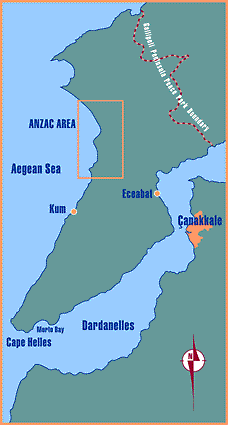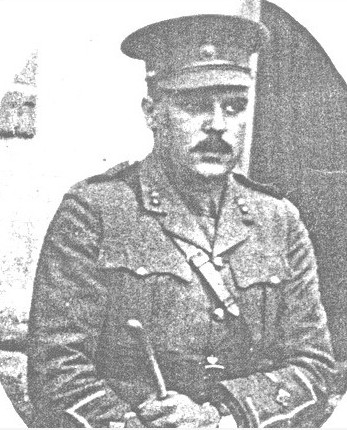Each year Australia commemorates the anniversary of Anzac Day on the 25th
of April as the day when
Anzacs landed onto the beaches of Gallipoli. The courage, honesty,
endurance, resourcefulness and loyalty
of Anzacs became an inspiration to this young nation.
Each year Australians commemorate this day in Australia and overseas,
mainly at Anzac Cove (Gallipoli-
Turkey) with great pride and respect to its great sons of Anzacs. They
recall that from the deeds and
sacrifices of the Anzacs at Gallipoli there emerged a powerful sense of
Australian identity and culture.
 In fact, the young Turkish soldiers on one side and the young Australian
soldiers on the other, were both
innocent victims of cruel and imperialist policies of the major super
powers of that time. All the wars are
unjustifiable and evil but this one was also an unofficial announcement
of
the birth of two nations:
Australians from a British colony and Turks from a collapsing Ottoman
Empire.
In fact, the young Turkish soldiers on one side and the young Australian
soldiers on the other, were both
innocent victims of cruel and imperialist policies of the major super
powers of that time. All the wars are
unjustifiable and evil but this one was also an unofficial announcement
of
the birth of two nations:
Australians from a British colony and Turks from a collapsing Ottoman
Empire.
Australians, fought against the enemy, alongside with the British Empire
Army and Navy in the land of
Turks - Anatolia.
The tragedy of Gallipoli, the history and the events of 1915, does not
diminish with the
passing of the years. Gallipoli remains an unforgettable part of the
military heritage of
Britain, Australia and New Zealand, and of many regiments and naval units
that took
part. It was the most infamous holocaust the world has ever known.
 Just the name Dardanelles has an enigmatic sound to it. This narrow
strategic passage
from the warm waters of the Mediterranean, through the sea of Marmara, and
from there
through the even narrower Bosphorus to the Black Sea, provides Russia's
only year round
ice free access to the world's oceans, an access historically coveted by
the Russians and
a cause of the Crimean war - another British amphibious operation of
disastrous
magnitude.
Just the name Dardanelles has an enigmatic sound to it. This narrow
strategic passage
from the warm waters of the Mediterranean, through the sea of Marmara, and
from there
through the even narrower Bosphorus to the Black Sea, provides Russia's
only year round
ice free access to the world's oceans, an access historically coveted by
the Russians and
a cause of the Crimean war - another British amphibious operation of
disastrous
magnitude.
This waterway was also the historic crossing for invaders
from Asia into Europe. At the
narrows near Canakkale, known as Hellespont, the Persian King Xerxes built
a bridge of
boats to launch his invasion of Greece. Centuries before the Trojan War
was fought at the
entrance to the Dardanelles
The combined British, French New Zealand and Australian troops landed at
dawn of the
25 April 1915. They landed along a dangerous coastline and were met with
devastating
resistance by the Turkish army who were at a very advantageous point on
the hillside.
The Anzacs landed on the eastern side as part of an operation involving 75
000 troops.
Something went horribly and tragically wrong. The plan was that the troops
land close to
an open plane but instead they found themselves a mile north to the north
and facing
steeply rising ridges and gorges.
 Initially, their plan was to surprise the enemy at dawn but instead they
found themselves on the firing line
from the Turkish defenders. 2000 of the 16 000 Anzacs were killed on the
first day. Among those who died
at Anzac Cove during this terrible siege was a Maltese/Australian soldier
by the name of Charles Bonavia.
His body, like many others, was never found.
Initially, their plan was to surprise the enemy at dawn but instead they
found themselves on the firing line
from the Turkish defenders. 2000 of the 16 000 Anzacs were killed on the
first day. Among those who died
at Anzac Cove during this terrible siege was a Maltese/Australian soldier
by the name of Charles Bonavia.
His body, like many others, was never found.
Several Maltese/Australians, including
fought side
by
side with the Australian troops.
Bonavia was born in Malta in 1888. His father was the registrar at the
Malta Law Courts and his
grandfather rose to the rank of Colonel in the Royal Malta Fencible
Artillery. Bonavia studied architecture at
the University of Malta and migrated to Australia in 1911.
He joined the 11th Battalion 3rd Infantry Brigade and sailed with his
regiment from Fremantle to Egypt on
2 November 1914. Bonavia's name is included in the list of the fallen
soldiers at Lone Pine and also at the
National War Memorial in Canberra. Other Maltese whose names are forever
recorded at Helles Memorial
overlooking the Dardanelles are Major Herbert Sammut who died when he was
in command of Essex
Regiment and Lieutenant Herbert Huber. Huber was a member of the Royal
Iniskilling Fusiliers and was
killed few hours before the British forces successfully evacuated from the
Turkish soil. Unfortunately, their
remains were never discovered.
 (Photo left) Captain Henry Curmi, who fought at Gallipoli in 1915 and many years later was appointed Malta's High Commissioner in Australia
(Photo left) Captain Henry Curmi, who fought at Gallipoli in 1915 and many years later was appointed Malta's High Commissioner in Australia
Many other Maltese migrants were among the casualties at Gallipoli.
According to the Maltese historian,
John Mizzi, there were 800 Maltese labourers serving under Maltese
officers in Gallipoli. A young private,
Giuseppe Camilleri, was 27 years old when he was killed in enemy action. He was
buried
close to the beach at Ari Burnu cemetry, near Anzac Cove (Row J, Grave4).
Indeed, Malta played a significant role in the Gallipoli campaign, not
only as a back up base for the royal
navy but also as one of the major hospitals in the Mediterranean. There
were also convalescent centres
and looked after 58 000 servicemen wounded during the World War I.
There are 1500 British and 202 Australian servicemen and 72 New Zealanders buried in Malta as well as
French, Indians and Egyptians
together with 26 Turkish prisoners. This was Malta's greatest contribution
to the Allied's efforts during this
terrible war.
The early Maltese settlers have indeed given their contribution to
preserve freedom and democracy in their
adopted home- Australia. Let us hope that the nations of the earth are
emerging from the self-destructive
practices of enmity and will build, in sunlight, a world of peace,
democracy and social justice.
Grand entry to islands
By LEUT Rachel Irving
With Maltese locals lining vantage points to watch, HMAS Anzac proudly sailed into the Grand Harbour, Malta, last week, one of only two RAN ships to do so in 43 years. The Sail Training Ship Young Endeavour visited Malta in 1992.
Arriving on May 2, the frigate spent two days at the tiny islands, which lie 100 kilometres south of Sicily
As Anzac neared Malta , her Seahawk helicopter transported 10 people to the ship who then remained onboard while the ship circumnavigated Malta (there are actually three islands which make up Malta � Malta , Gozo and Comina).
Amongst the VIPs were two lucky 13-year old school children, Eric Leone and Marija Caruana.
Eric and Marija were winners in a competition running in the weeks prior to Anzac's arrival. The competition, overseen by the Australian High Commission in Malta , asked for school children to write on the topic �What is ANZAC and is there a link with Malta �.
�I wrote about the Anzacs at Gallipoli and the diggers who were buried here (in Malta ),� said Eric, who researched his topic for several days via the internet.
Both Eric and Marija, agreeing their day was much better than being at school, spent several hours on the ship receiving a tour and lunch before the ship berthed.
Later that night, Anzac hosted the President of Malta, Dr Edward Fenech-Adami, at a cocktail party on the flight deck.
Welcoming the ship, the President stressed the importance history has played on the relationship between Malta and Australia and said he hoped it wasn't another 43 years before an RAN ship visited again.
There are several significant moments of history which link Australia and Malta . Many diggers from Gallipoli were evacuated to Malta and some subsequently buried there. Then, in 1940 when Italy entered the war and began to bomb the islands, five Australian ships known as the 19 th Destroyer Division came to help Malta .
Malta is the only country to be awarded the George Cross, Britain 's highest civilian honour for bravery, for courage shown in defending the islands during the period 1940-1943, now known as the Siege of Malta.
Malta also holds the dubious record for the heaviest sustained bombing attack � in 1942 from January to April alone, some 154 days and nights, 6,700 tons of bombs reigned down on Malta .
Though devastated at the time, Malta continues to rebuild itself and as the ship's company of Anzac would attest, is definitely a place to put on the list of �must visits'.
Further reading Click here



